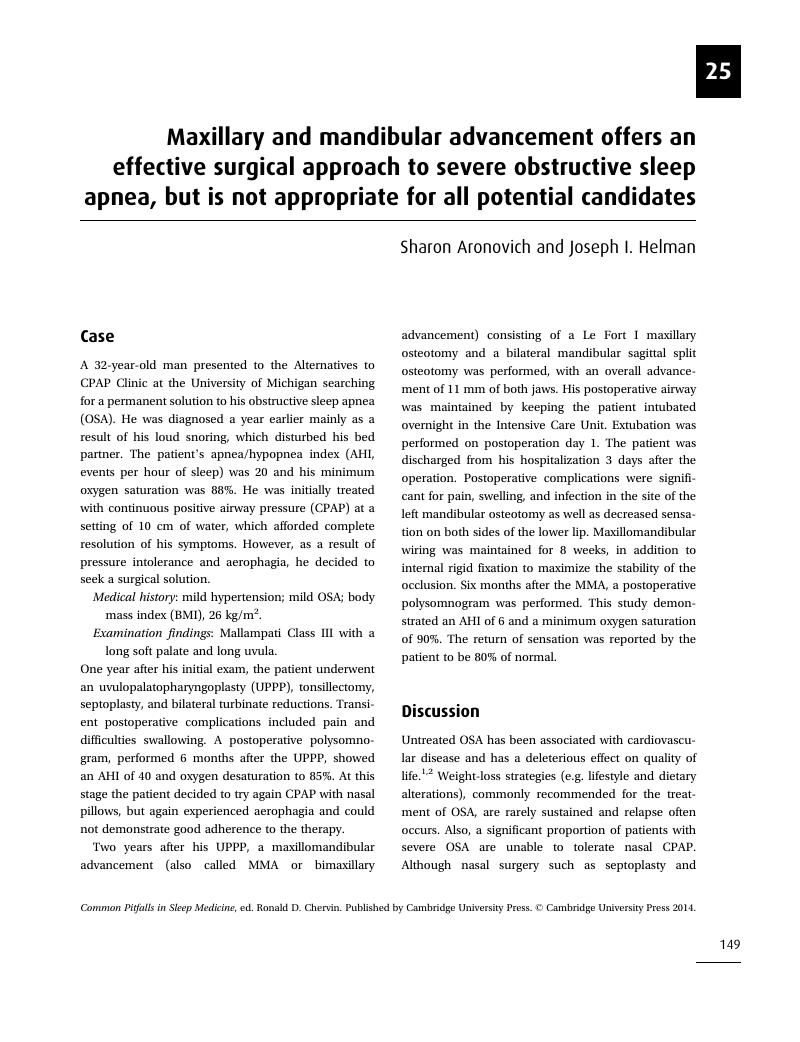Book contents
- Common Pitfalls in Sleep Medicine
- Common Pitfalls in Sleep Medicine
- Copyright page
- Contents
- Contributors
- Preface
- Acknowledgements
- 1 Introduction: the complexity, challenges, and rewards of effective sleep medicine
- Section one Sleepiness versus fatigue, tiredness, and lack of energy
- Section two Assessment of daytime sleepiness
- Section three Diagnosis of narcolepsy
- Section Four Diagnosis of obstructive sleep apnea
- Section Five Positive airway pressure to treat obstructive sleep apnea
- Section Six Alternatives to positive airway pressure in the treatment of obstructive sleep apnea
- 22 Some patients with sleep apnea who are intolerant to continuous positive airway pressure can be treated most effectively with a mandibular advancement device
- 23 Inadequate preoperative assessment risks ineffective surgical treatment of obstructive sleep apnea
- 24 Genioglossus advancement and hyoid suspension carries risks and may not obviate the need for subsequent use of continuous positive airway pressure
- 25 Maxillary and mandibular advancement offers an effective surgical approach to severe obstructive sleep apnea, but is not appropriate for all potential candidates
- Section Seven Diagnosis and treatment of chronic insomnia
- Section Eight Restless legs syndrome and periodic leg movements
- Section Nine Parasomnias
- Section Ten Circadian rhythm sleep disorders
- Section Eleven Missed diagnoses of obstructive sleep apnea can exacerbate medical and neurologic conditions
- Section Twelve Sleep in children
- Section Thirteen Sleep in older persons
- Index
25 - Maxillary and mandibular advancement offers an effective surgical approach to severe obstructive sleep apnea, but is not appropriate for all potential candidates
from Section Six - Alternatives to positive airway pressure in the treatment of obstructive sleep apnea
Published online by Cambridge University Press: 05 April 2014
- Common Pitfalls in Sleep Medicine
- Common Pitfalls in Sleep Medicine
- Copyright page
- Contents
- Contributors
- Preface
- Acknowledgements
- 1 Introduction: the complexity, challenges, and rewards of effective sleep medicine
- Section one Sleepiness versus fatigue, tiredness, and lack of energy
- Section two Assessment of daytime sleepiness
- Section three Diagnosis of narcolepsy
- Section Four Diagnosis of obstructive sleep apnea
- Section Five Positive airway pressure to treat obstructive sleep apnea
- Section Six Alternatives to positive airway pressure in the treatment of obstructive sleep apnea
- 22 Some patients with sleep apnea who are intolerant to continuous positive airway pressure can be treated most effectively with a mandibular advancement device
- 23 Inadequate preoperative assessment risks ineffective surgical treatment of obstructive sleep apnea
- 24 Genioglossus advancement and hyoid suspension carries risks and may not obviate the need for subsequent use of continuous positive airway pressure
- 25 Maxillary and mandibular advancement offers an effective surgical approach to severe obstructive sleep apnea, but is not appropriate for all potential candidates
- Section Seven Diagnosis and treatment of chronic insomnia
- Section Eight Restless legs syndrome and periodic leg movements
- Section Nine Parasomnias
- Section Ten Circadian rhythm sleep disorders
- Section Eleven Missed diagnoses of obstructive sleep apnea can exacerbate medical and neurologic conditions
- Section Twelve Sleep in children
- Section Thirteen Sleep in older persons
- Index
Summary

- Type
- Chapter
- Information
- Common Pitfalls in Sleep MedicineCase-Based Learning, pp. 149 - 154Publisher: Cambridge University PressPrint publication year: 2014

